DFI LANParty UT nF3-250Gb: Overclocker's Dream
by Wesley Fink on September 8, 2004 12:05 AM EST- Posted in
- Motherboards
Basic Features: DFI LANParty UT nF3 250Gb
| DFI LANParty UT nF3 250Gb Motherboard Specifications | |
| CPU Interface | Socket 754 Athlon 64 |
| Chipset | nVidia nForce3-250Gb |
| Bus Speeds | 200MHz to 456MHz (in 1MHz increments) |
| PCI/AGP Speeds | 66MHz to 100MHz (in 1MHz increments) |
| Core Voltage | Auto, 0.8V to 1.55V in .025V increments plus Vid Special multiplier of 4%, 10%, 13%, 23%, 26%, 33%, 36% - TO 2.1V |
| DRAM Voltage | Auto, 2.5V to 3.1V in 0.1V increments (to 3.3V with future BIOS) |
| AGP Voltage | 1.5V-1.9V in 0.1V increments |
| Chipset Voltage | 1.6V-1.9V in 0.1V increments |
| Hyper Transport Ratios | Auto, 1x, 1.5x, 2x, 2.5x, 3x, 4x, 5x |
| CPU Ratios | Auto, 4.0x to 20.0x in 0.5X increments |
| DRAM Speeds | Auto, 100, 120, 133, 140, 150, 166, 180, 200 |
| Memory Slots | Three 184-pin DDR Single-Channel Slots Unbuffered Non-ECC Memory to 2GB Total |
| Expansion Slots | 1 AGP 8X Slot 5 PCI Slots |
| Onboard SATA | 4-Drive SATA by nF3-250Gb |
| Onboard IDE | Two Standard nVidia ATA133/100/66 (4 drives) |
| SATA/IDE RAID | 4-Drive SATA Plus 4-Drive IDE can be combined in nVidia RAID 0, 1, 0+1, JBOD |
| Onboard USB 2.0/IEEE-1394 | 8 USB 2.0 ports supported by nF3-250Gb 2 1394A FireWire ports by VIA VT6307 |
| Onboard LAN | 1Gigabit Ethernet on-chip by nF3-250GB and Marvel PHY |
| Onboard Audio | Realtek ALC850 8-Channel with UAJ SPDIF coaxial in and out |
| BIOS | Award 8/27/2004 |
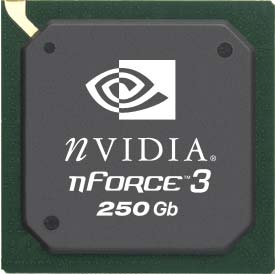
The single chip nVidia nForce3-250Gb is used for DFI LANParty UT. For more information on this chipset, you can refer to our launch articles for the chipset:
nForce3-250 - Part 2: Taking Athlon 64 to the Next Level
nForce3-250 - Part 1: Taking Athlon 64 to the Next Level
DFI has implemented the full feature set of the nVidia nForce3-250Gb, which includes on-chip Gigabit LAN, nVidia Firewall, and the nVidia "any-drive" RAID, which can control both the 4 SATA and IDE drives in a RAID configuration. On a board whose main purpose is to be the best overclocking board on the market, it is refreshing to see that DFI could still implement all of the unique features of the 250Gb chipset.
Since our test board was a production sample, we did not receive a full retail package because the packaging and manuals were still not available. DFI tells us that the shipping retail motherboard package will include:
- A user's manual
- Two round IDE cables
- One round floppy cable
- Two Serial ATA data cables
- One Serial ATA power cable
- One "nVRAID Driver" diskette
- One I/O shield
- One "Mainboard Utility" CD
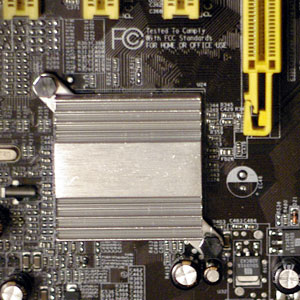
DFI used just a short passive heatsink on the single chip nF3 250GB. The heatsink got very hot after running for a few hours, particularly during overclocking. While this didn't appear to limit our overclocks, the chipset did get hot enough that you should consider replacing the small chipset heatsink with a larger passive heatsink or an active heatsink and fan. DFI uses standard mounting holes for the heatsink, so replacement should be fairly easy. Fortunately, there is also a fan header conveniently located near the chipset. While there were no crashes from the heat and overclocks were still record-setting, we wondered how much higher we might have gone with better chipset cooling.
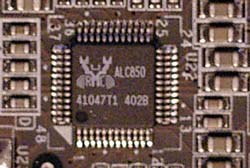
Many of the second generation boards have chosen the Realtek ALC850 7.1 audio chip. DFI also uses the 850 and provides a full implementation of audio jacks and SPDIF connections to fully support the audio chip. This 8-channel audio codec is fully AC '97 2.3 compliant and features 16-bit 8-channel audio and auto-jack sensing with support for a full range of analog and digital IO. A wide range of sound standards are supported including:
- EAXTM 1.0 & 2.0 compatible
- Direct Sound 3DTM compatible
- A3DTM compatible
- I3DL2 compatible
- HRTF 3D positional audio
- SensauraTM 3D Enhancement
You can find more information on the recently released ALC850 at Realtek product information.

DFI supports the ALC850 with 6 audio mini jacks plus both coaxial SPDIF in and out connectors on the back IO panel. Optical audio connections are not supported. IO also includes PS2 mouse and keyboard, parallel, 1 serial, 1 standard Firewire (IEEE1394), 4 USB, and a Gigabit Ethernet.
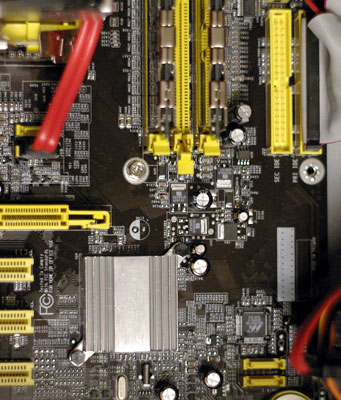
The DFI nF3 250Gb fully supports nVidia "Any Drive" RAID. Any of the standard 4 IDE drives or an additional 4 SATA drives can be combined in a Raid 0 (striping), Raid 1 (Mirroring), or Raid 0+1 array. This is the most flexible RAID arrangement that we have seen built into any chipset.
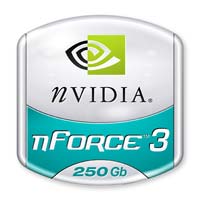
On-chip Gigabit LAN is built-in with the nF3-250Gb and runs completely independently of the PCI bus. The Marvel PHY (Physical Layer) chip provides the interface for direct communication of the LAN to the chipset. This ensures that the LAN is always capable of providing the fastest throughput possible with your LAN connections.
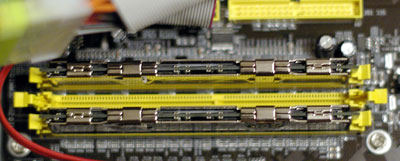
Three DIMM slots support up to 2GB of up to DDR400 memory in a Single-Channel memory configuration.
If you are wondering why this performance board does not use the Socket 939 chipset with Dual-Channel memory, we would have to guess that it is about performance, cost, and availability. First, the Athlon 64 is not as dependent on memory bandwidth as Pentium 4 solutions. The single-channel socket 754 is just as fast as the dual-channel Athlon 64 chips in many applications. Second, the only Athlon 64 chips currently available for Socket 939 are pretty expensive and overclockers always enjoy pushing cheaper parts to their absolute limits. Third, cheaper Socket 754 parts are available all the way from the $120 Sempron 3100+ to the 3700+ 2.4GHz. This covers the full range of speeds available for Athlon 64.
DFI tells us that there will be a Socket 939 board in the LANParty series a bit later, but they believe that the biggest demand for an overclocking board right now is in Socket 754.










54 Comments
View All Comments
rjm55 - Thursday, September 9, 2004 - link
Saw the DFI at www.gameve.com for $130. ZZF had them for a bit at a similar price. It looks like it will be affordable.deathwalker - Thursday, September 9, 2004 - link
Sweet Mobo...sounds inviting for my planned system upgrade from my Abit NF7-S with my O/C 2500 mobility proc...only concern...will I have to mortgage my home to be able to afford this board...afterall..these goodies do come with a price tag.rjm55 - Thursday, September 9, 2004 - link
Which is the better overclocker - the 2.0 1024k 3400+ or the 2.2 512k 3400+? Has anyone tested both?Wesley Fink - Thursday, September 9, 2004 - link
#40 - Both versions of the 3200+ are now mentioned at the bottom of page 9 - 2.0GHz with 1024k cache and 2.2GHz with 512k cache. Our test 3200+ was a 2.0GHz 1024k version.Jedi2155 - Wednesday, September 8, 2004 - link
did anyone else noticed the error about the 3200+ @ the bottom of page 9 :-).rjm55 - Wednesday, September 8, 2004 - link
I'm releived to know 1GB dimms work fine. It didn't make sense that other 754 had no problems with 1GB dimms and this one did. I'm glad DFI cleared up the confusion.Wesley Fink - Wednesday, September 8, 2004 - link
I just spoke with Oskar Wu, the board's designer. Oskar says they have 1GB dimms from Samsung that work fine on the LANParty UT, and that the Samsung 1GB dimms use 512MB chips in their construction. He said the only reason for the caution on 512MB chips (not dimms) was because they have not verified operation with dimms made with 1GB chips. All of the 1GB dimms I have here for testing use 512MB chips in their construction.Oskar also stated that 2 dimms work best in dimm slots 1 and 2, and not 1 and 3. He said try 1 and 2 and you will get better performance with 2 dimms.
Bozo Galora - Wednesday, September 8, 2004 - link
I just went there to check it out - #33 was wrong.It supports 512 MegaBIT DEVICES - DRAMS, not sticks.
cnq - Wednesday, September 8, 2004 - link
Yeah, I saw that too. I didn't know that any 754 motherboards forbade using a 1GB DIMM. Who knows, maybe it's a misprint on DFI's part...we can always hope.laxxy - Wednesday, September 8, 2004 - link
where does it say it supports only 512M?here:
http://www.dfi.com.tw/Product/xx_product_spec_deta...
it states that it
> Supports up to 3GB memory when using DDR333
> Supports up to 2GB memory when using DDR400
???